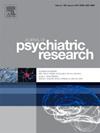怀孕期间血压轨迹与分娩相关创伤后应激障碍症状之间的关系
IF 3.7
2区 医学
Q1 PSYCHIATRY
引用次数: 0
摘要
背景孕期血压变化与分娩相关创伤后应激障碍(CB-PTSD)之间的关系研究较少。本研究旨在探讨妊娠期血压变化轨迹对cbptsd症状的影响。方法该队列研究于2022年10月至2023年8月在中国佛山进行。在产后2-3天招募符合条件的妇女,并从医疗记录中回顾性检索妊娠血压数据。采用围产期创伤后应激障碍问卷(PPQ)评估产后42天的CB-PTSD症状。使用潜在类别增长模型来识别血压轨迹,并使用逻辑回归模型来估计血压轨迹与CB-PTSD症状之间的关联。结果在709名妇女中,67名(9.4%)在产后42天内表现出临床显著的CB-PTSD症状。确定了三种不同的收缩压(SBP)和舒张压(DBP)轨迹和两种脉压(PP)轨迹。Logistic回归分析显示,高下降PP组出现CB-PTSD症状的风险低于低下降PP组(OR = 0.59, 95% CI = 0.36-0.97)。调整混杂因素后,中-慢速增长收缩压组(OR = 0.52, 95% CI = 0.28-0.94)比低-快速增长收缩压组出现CB-PTSD症状的风险更低。调整后,高下降PP组(OR = 0.44, 95% CI = 0.25-0.79)出现CB-PTSD症状的风险仍低于低上升PP组。结论妊娠期不同的血压变化模式与CB-PTSD症状相关,血压波动幅度越大,可能产生的影响越大。未来的研究应该探索这些关联的潜在生物学和心理学机制。本文章由计算机程序翻译,如有差异,请以英文原文为准。
Association between blood pressure trajectories during pregnancy and childbirth-related post-traumatic stress disorder symptoms
Background
Research on the association between blood pressure changes during pregnancy and childbirth-related post-traumatic stress disorder (CB-PTSD) is scarce. This study aimed to explore the impact of blood pressure trajectories during pregnancy on CB-PTSD symptoms.
Methods
This cohort study was conducted from October 2022 to August 2023 in Foshan,China. Eligible women were recruited 2–3 days postpartum, with pregnancy blood pressure data retrospectively retrieved from medical records. The Perinatal Post-Traumatic Stress Disorder Questionnaire (PPQ) was used to assess CB-PTSD symptoms 42 days postpartum. A latent class growth model was employed to identify blood pressure trajectories, and logistic regression models were used to estimate the associations between blood pressure trajectories and CB-PTSD symptoms.
Results
Among the 709 women included in the study, 67 (9.4 %) exhibited clinically significant CB-PTSD symptoms within 42 days postpartum. Three distinct systolic blood pressure (SBP) and diastolic blood pressure (DBP) trajectories and two pulse pressure (PP) trajectories were identified. Logistic regression analysis showed that the risk of CB-PTSD symptoms was lower in the high-declining PP group (OR = 0.59, 95 %CI = 0.36–0.97) than the low-increasing PP group. After adjusting for confounders, the medium-slow-increasing SBP group (OR = 0.52, 95 %CI = 0.28–0.94) had a lower risk of CB-PTSD symptoms than the low-fast-increasing SBP group. The high-declining PP group (OR = 0.44, 95 %CI = 0.25–0.79) remained associated with a lower risk of CB-PTSD symptoms than the low-increasing PP group after adjustment.
Conclusions
Different patterns of blood pressure changes during pregnancy are associated with CB-PTSD symptoms, with wider blood pressure fluctuations potentially exerting a greater impact. Future research should explore the underlying biological and psychological mechanisms of these associations.
求助全文
通过发布文献求助,成功后即可免费获取论文全文。
去求助
来源期刊

Journal of psychiatric research
医学-精神病学
CiteScore
7.30
自引率
2.10%
发文量
622
审稿时长
130 days
期刊介绍:
Founded in 1961 to report on the latest work in psychiatry and cognate disciplines, the Journal of Psychiatric Research is dedicated to innovative and timely studies of four important areas of research:
(1) clinical studies of all disciplines relating to psychiatric illness, as well as normal human behaviour, including biochemical, physiological, genetic, environmental, social, psychological and epidemiological factors;
(2) basic studies pertaining to psychiatry in such fields as neuropsychopharmacology, neuroendocrinology, electrophysiology, genetics, experimental psychology and epidemiology;
(3) the growing application of clinical laboratory techniques in psychiatry, including imagery and spectroscopy of the brain, molecular biology and computer sciences;
 求助内容:
求助内容: 应助结果提醒方式:
应助结果提醒方式:


